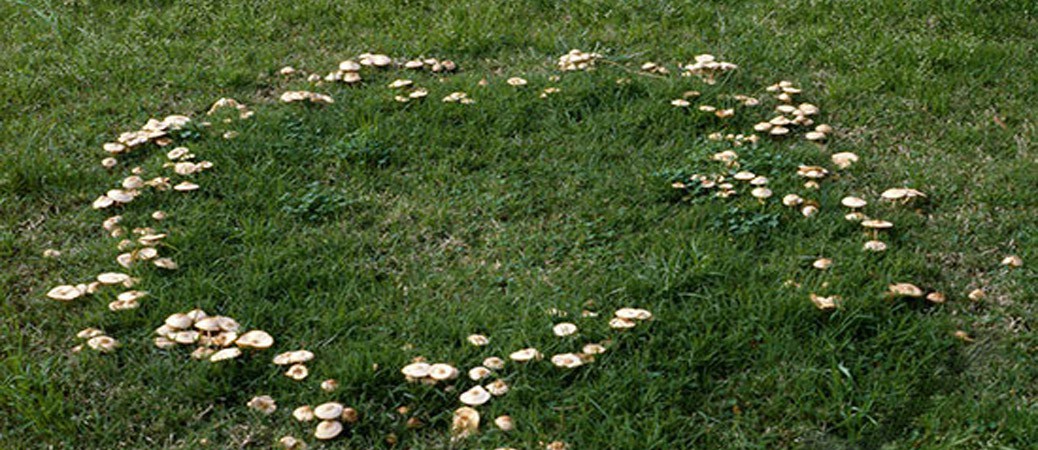Fairy rings- circles of mushrooms growing in yards are known—and sometimes respected- by both children and grown-ups. “Respected” because, according to Irish and Welsh legend, they are places inhabited by the wee folk, fairies and leprechauns. Within the circles they dance, sometimes enticing a human passer-by to join them, much to his eventual regret. Once inside the ring, he cannot get out and is compelled to dance until exhaustion and death carry him away. Fairy rings deserve respect: it is at your own peril if you enter them.

Many kinds of mushrooms form fairy rings, but the commonest is probably Marasmius oreades, the fairy ring mushroom. It has an off-white cap with widely spaced gills, a slender fibrous stalk without a ring, and white spores. Unlike most mushrooms which decay and rot over time, Marasmius mummifies in summer heat, shrinking to a fraction of its fresh size, its firm flesh becoming tough and leathery over time.
If a fresh rain falls upon the mushroom, it perks up, expanding to its former size and regaining its firm texture. Not only does it appear to resurrect itself, it actually does that very thing. It has been shown that Marasmius oreades resumes its life processes, respiring and consuming food, even producing new spores on its gills. Somehow it goes into suspended animation for as long as a summer drought holds on, only to continue its business when growing conditions improve.
One hypothesis explaining the resurrection is the presence of a special sugar within the flesh of the mushroom, trehalose. After a dry spell, rainwater is absorbed, thereby dissolving the sugar–which enters cells, reviving and stimulating them to divide. This Marasmius is considered edible (but not especially delicious), having been incorporated into recipes for omelets, gravies, and even chocolate chip cookies. Perhaps the trehalose sugar helps the cookies taste better, though I suspect that the best change to the recipe would be to leave the mushrooms out.

Marasmius oreades grows in circles for a very good reason. It starts out when a mushroom spore lands in a favorable place for food, decayed matter underground. It spreads out a net of slender cells, hyphae (collectively called the mycelium), eventually reaching a size large enough to send up its first fruiting bodies, the familiar mushrooms we see above ground. Year by year the mycelium grows outward, forever producing new crops of mushrooms at its outer margin. The circle gets bigger, five feet in diameter, then ten, then even larger—certainly big enough to accommodate a large band of dancing fairies and an occasional hapless human.
Within the circle the grass may appear yellow and exhausted: the mushroom has absorbed nutrients in the soil, while at the edge it may be green and luxuriant as nutrients are released to be absorbed by the fungus and neighboring grass plants. Overzealous yard managers sometimes try to get rid of the circles of mushrooms, preferring the monotony of turf to the disorderliness of fairy ring mushrooms. They are seldom successful.
To end this piece one can do no better than to quote a poem about fairy rings, this one unsigned:
If you see a fairy ring
In a field of grass,
Very lightly step around,
Tiptoe as you pass;
Last night fairies frolicked there,
And they’re sleeping somewhere near.
If you see a tiny fay
Lying fast asleep,
Shut your eyes and run away,
Do not stay or peep;
And be sure you never tell,
Or you’ll break the fairy spell.
Richard Fidler is co-editor of Grand Traverse Journal.

